
Worth A Look: 'Urban Cadence' at Weisman Art Museum
Published October 11th, 2023 by Russ White
The traveling exhibition features street photography from Lagos and Johannesburg, showing a variety of vantage points from within two ever-growing African megacities
"Worth a Look" is a series of semi-regular essays about excellent art, interesting ideas, and whatever other cool stuff we find around town. Go see art; it's good for you.
It can be a frustrating experience to have the name of your city on the tip of the world’s tongue. It happened to Minneapolis in 2020 — national news reporters swooping in, trying to snapshot and soundbite their way to an understanding of this place. Visits to family in North Carolina, even as recently as last month, still include hushed gasps from concerned locals when I tell them where I’m visiting from. I guess I shouldn't be surprised. Hell, the tough dads and dudebros that haunt the Star Tribune’s comments sections from the suburbs to this day talk about how scared they are to visit, and they only live fifteen or twenty minutes away.
That’s because (among other reasons) they’re not getting the whole picture. A traveling exhibition up now at the Weisman Art Museum ponders whether that whole picture of a place is even possible. Urban Cadence, on tour from Gund Gallery at Kenyon College, takes Lagos, Nigeria, and Johannesburg, South Africa, as its case studies, intermingling street photography from nine different photographers — crucially, ones that are actually from the places they’re shooting.
The effect at first, walking into WAM’s main gallery, is that of flipping through a National Geographic or a Life magazine in their heyday: you are met with a difficult mix of familiarity and foreignness. It may take you some time to get your bearings. Even as you recognize architectural styles or clothing brands, you come face to face with strangers shining your ignorance about their lives back at you like a mirror. This, for them, is the everyday, just as much as this visit to the Weisman is mine. Curator Carol Magee opens her essay in the exhibition catalogue by talking about the rapid growth these cities are experiencing and wondering what photography can do to help us contextualize it. What the photographers are capturing, Magee writes, are the cities' rhythms. “Whether sobering, humorous, or unexpected, the visuals of Urban Cadence invite you to ponder African urban life in the early twenty-first century," she writes. "Cadence is the leitmotif that will guide you in this contemplation."
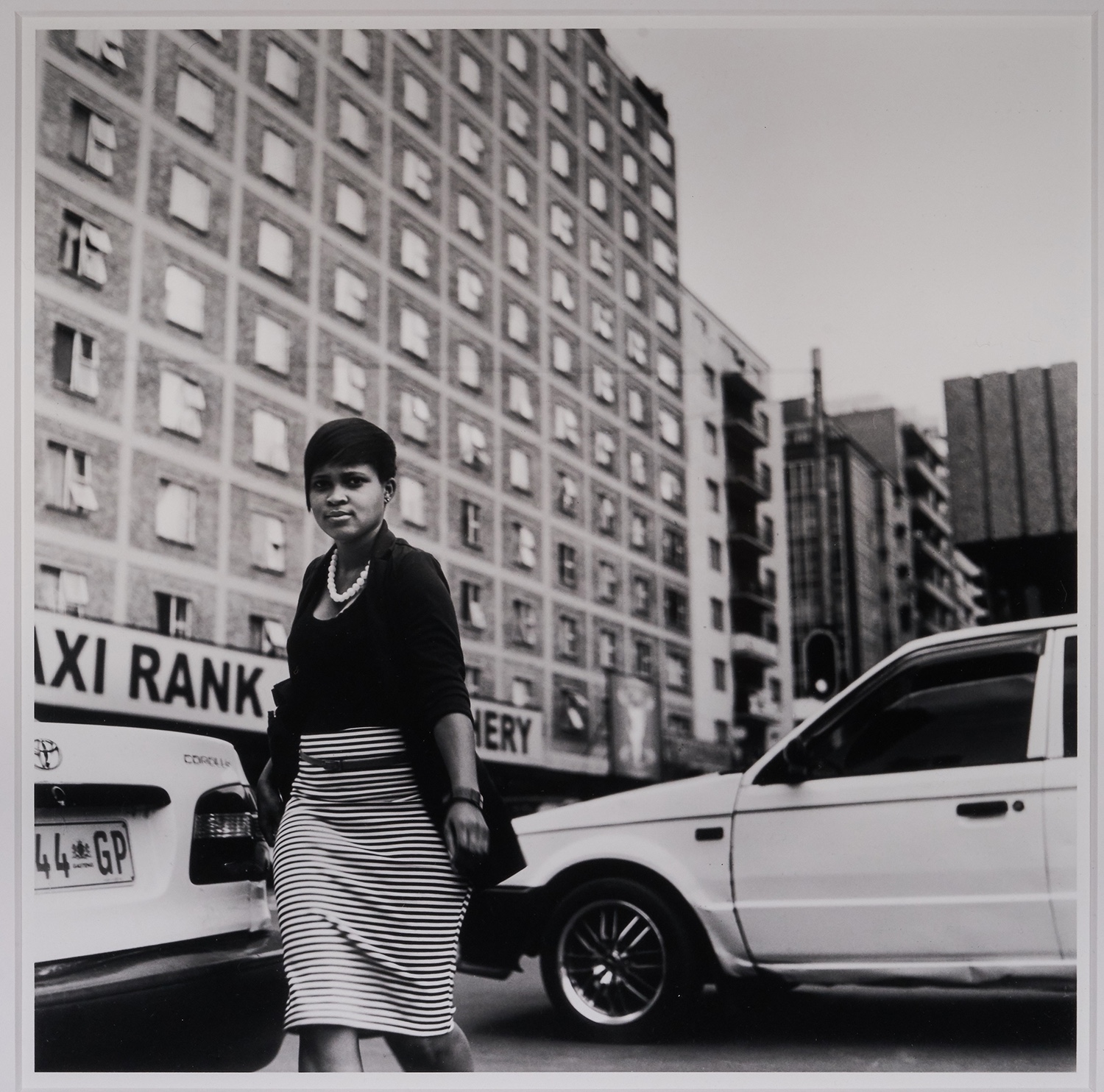 Sabelo Mlangeni (South African, b.1980), Woman and city (Big City series), 2012. Gelatin silver print. 18 x 15 3/8 inches. Courtesy of the artist.
Sabelo Mlangeni (South African, b.1980), Woman and city (Big City series), 2012. Gelatin silver print. 18 x 15 3/8 inches. Courtesy of the artist.
A close look at the labels will tell you which city you’re seeing inside each frame, and soon you’ll start to recognize the particular styles and interests of each photographer. This is, after all, a group show — a collection of voices and visions all curated down to something digestible, if not entirely coherent. You will not leave this show knowing these places; to understand the histories, the peoples, the economies — the cultures — of these places would take years of study and experience. Instead, the photographers open their viewfinders to us, showing us the Lagos and Johannesburg that they see. Sabelo Mlangeni’s Woman and City opens the show: a black and white street scene that begins and ends in medias res. A woman walks past the camera, en route from one part of her day to another. She passes two cars and a nondescript apartment building in the background, each window another person's hidden, private life. Mlangeni’s shots are often action suspended — a road being repaved, a pedestrian crossing a street, street sweepers ambling home. Jodi Bieber’s large-scale photos, by contrast, feel more meticulously constructed, more theatrically produced, sacrificing a bit of the spontaneity of street shooting for the polish of a well-considered composition. Her big red fire engine, for instance, is framed just so; a wedding party lounges on a sports car in an informal but still perfect pose; the Sowetan alt-rock band is caught in the midst of a triumphant jam, the singer’s locks splayed out joyously above his head. In the background — again, perfectly framed — a cement wall. Some urban vistas glisten in glass and steel. These look more to cement, corrugated sheetmetal, and weathered road signs — all of which, you might notice, are in English.
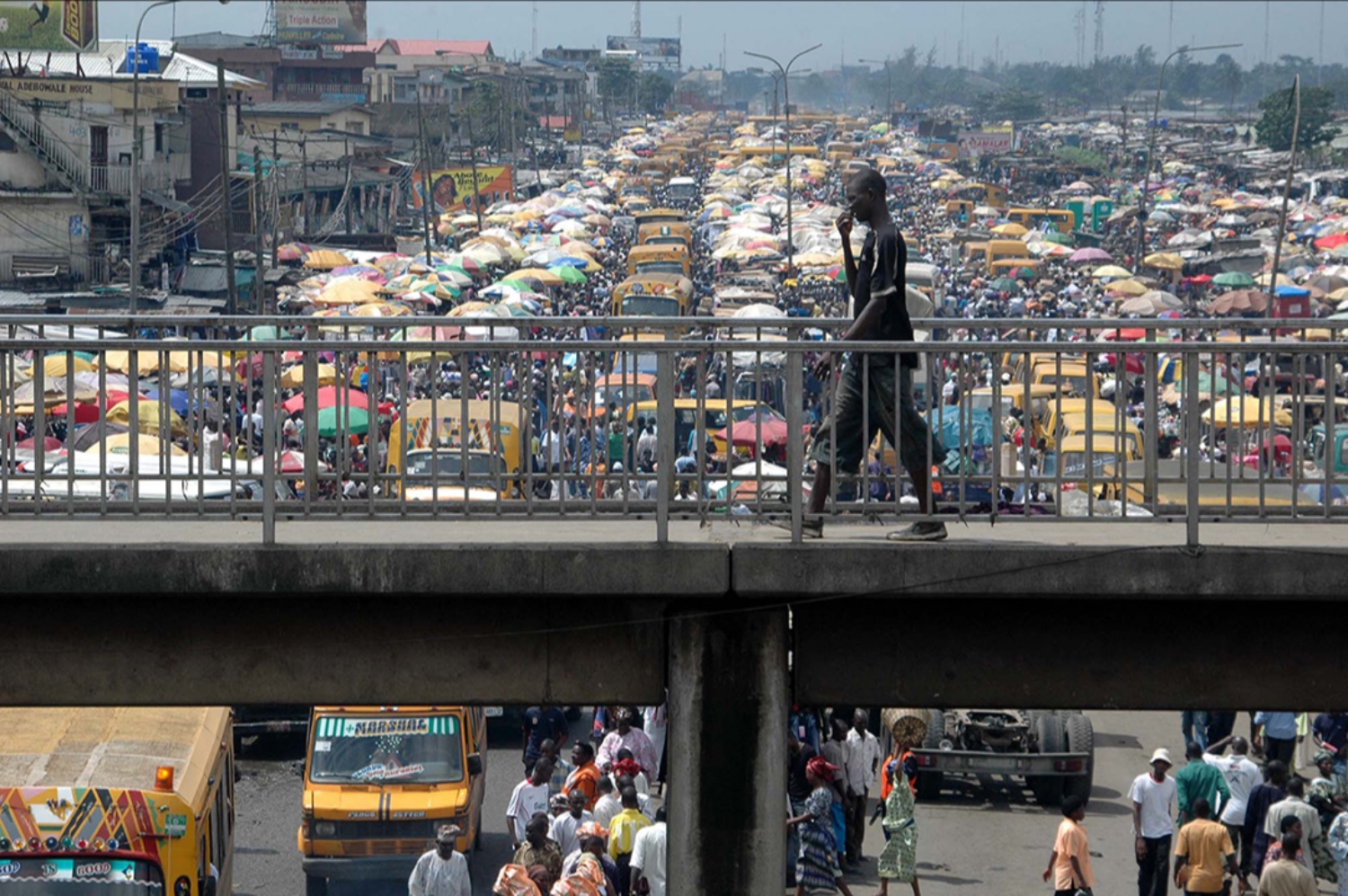
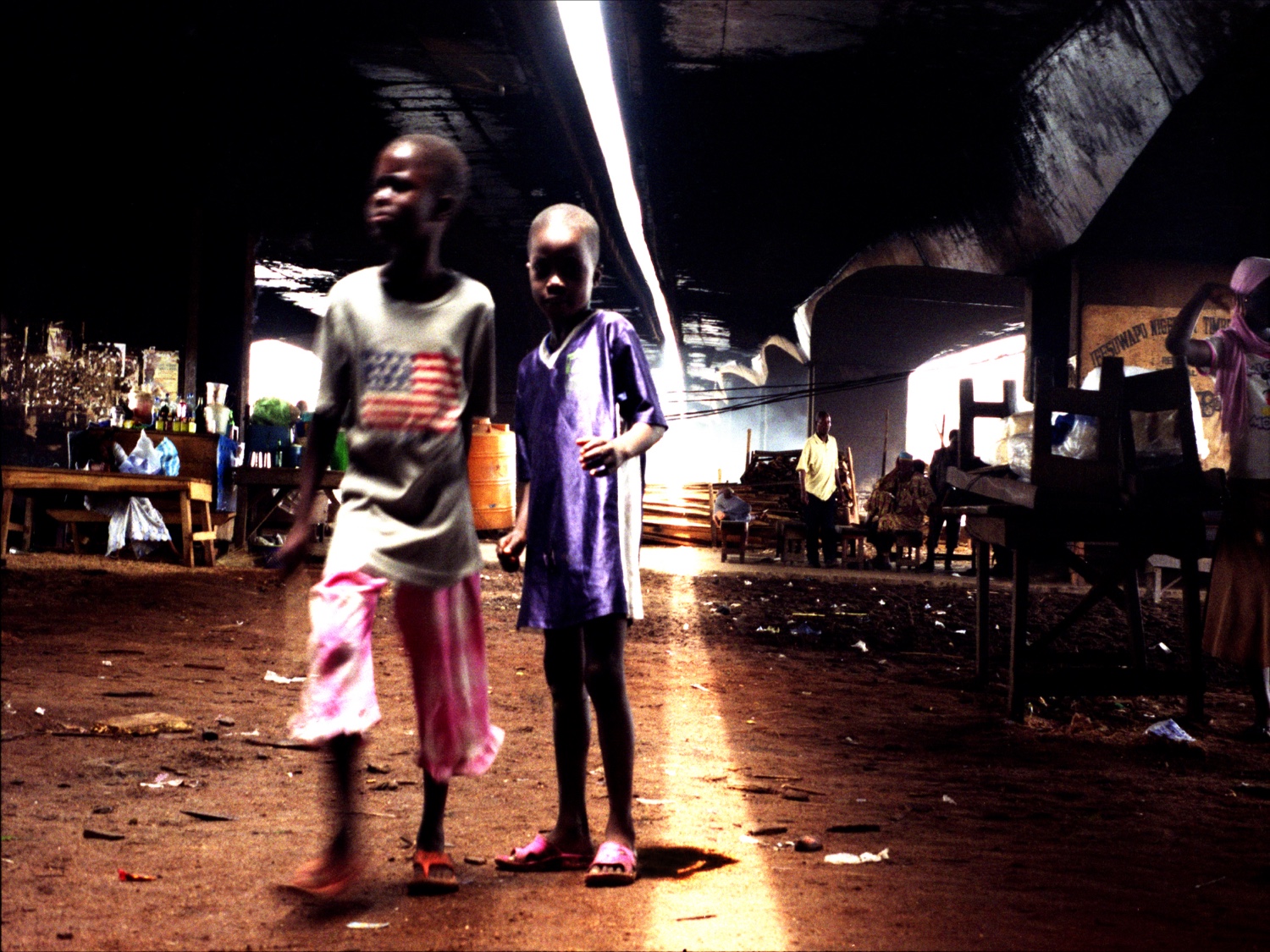 Top: Akintunde Akinleye (Nigerian, b.1971), Each Passing Day, 2006. Digital print. 29 1/4 x 39 3/4 inches. Courtesy of the artist. Bottom: Uche Okpa-Iroha (Nigerian, b.1972). American Dream, 2008. Digital print. 31 1/2 x 23 5/8 inches. Courtesy of the artist.
Top: Akintunde Akinleye (Nigerian, b.1971), Each Passing Day, 2006. Digital print. 29 1/4 x 39 3/4 inches. Courtesy of the artist. Bottom: Uche Okpa-Iroha (Nigerian, b.1972). American Dream, 2008. Digital print. 31 1/2 x 23 5/8 inches. Courtesy of the artist.
The exhibition has been divided thematically into thirds, but like life in a city, it all kind of bleeds together. The streets of Lagos that Akinbode Akinbiyi snaps in black and white show up again as clogged arteries in Akintunde Akinleye's full color shots. They appear yet again from below, as the roof over a makeshift shelter in Uche Okpa-Iroha’s Under Bridge Life triptych, perhaps the most arresting works in the show. A ribbon of white zips through the dark ceiling, a curved crack of sunlight between the two roadways above. The faces and bodies of the people below blur in each shot, but the setting remains static, mixing a kinetic energy with the sense that this situation has many years of history and likely many more to come. Next to these pictures in the gallery are Mlangeni’s street sweepers, anonymous women studiously cleaning out the gutters and curbs of Johannesburg streets in the dead of night, preparing it for another busy day. They are nameless and faceless to us, but in the exhibition catalogue, writer Erin Dickey explains that for this series, “Mlangeni spent eight months developing rapport with and documenting Johannesburg’s night sanitation workers.” That tenderness and respect comes through.
You come out of the exhibition, fittingly, remembering only snapshots rather than the whole picture. The canopy of electrical wires engorging a lone light pole in Lagos; the hand-painted sign advertising “Repair Your Bone Here” above a phone number; the caped, shirtless Captain Rugged standing tall above a bustling Johannesburg. Others fade in your memory as soon as you leave the show. Perhaps the photographer who sums it up best is Jo Ractliffe, whose long panoramas blend together disparate images like a contact sheet turned Instagram feed you’re swiping quickly through. There is a rhythm, a cadence, to another person’s — and another people’s — experience that you can never fully catch. That’s the beauty of Babel, I suppose, that we each all have our own languages and locales, the rhythms of which we make and are made by.
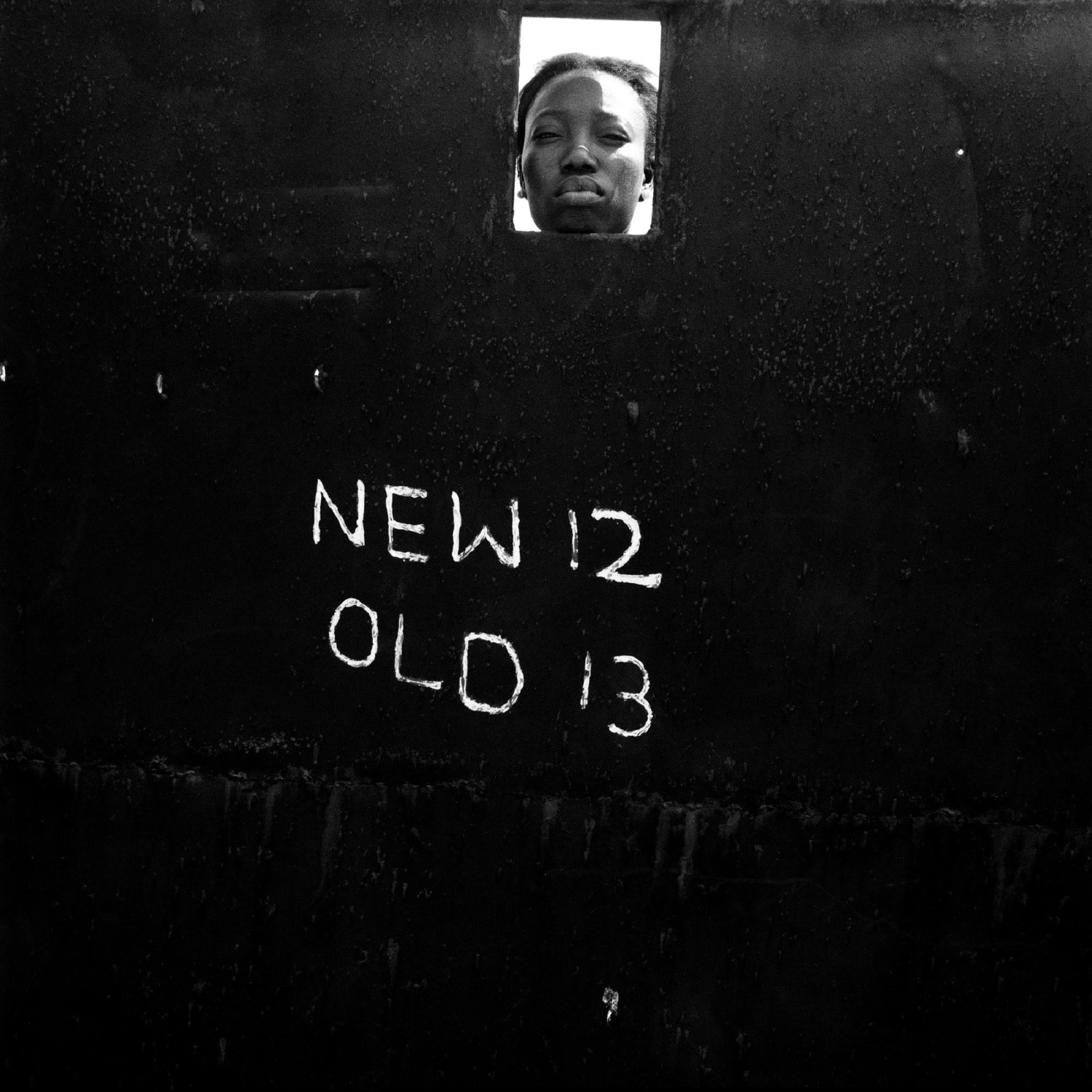 Uche Okpa-Iroha (Nigerian, b. 1972), Old & New (Isolated series), 2011. Digital print on Dibond/aluminum. 39 3/8 x 39 3/8 inches. Courtesy of the artist.
Uche Okpa-Iroha (Nigerian, b. 1972), Old & New (Isolated series), 2011. Digital print on Dibond/aluminum. 39 3/8 x 39 3/8 inches. Courtesy of the artist.
In the final section of the exhibition, there is another showstopper of an image by Okpa-Iroha. The photo is printed large and is entirely black — banged up and textured — except for two elements: a handwritten phrase in thin white paint reading “New 12 Old 13” and, above that, a small rectangular hole through which a beautiful young woman peers out, looking squarely at the viewer. The catalogue explains that “what is presented here is the result of Lagos’s housing agency’s efforts to properly identify buildings in the city… This process often required issuing a building a new number that was different from its previous number,” and so both addresses are written on doors to help with mail delivery.
The woman is on the inside of a changing city looking out, skeptical of the cameraman and, you might guess, just where this captured image might end up. Here, some 6,200 miles away, we look up to meet her gaze and marvel at another life caught only in glimpses, only in snippets. You could imagine a similar show on the opposite end of the earth with pictures of an encampment along Cedar or construction on Lake or skyways downtown; of a great river criss-crossed with bridges and dams; of commuters and panhandlers and jingle dress dancers and, most certainly, a scorched out husk of a police precinct. And it wouldn’t come close to explaining this city. That show would tell you more about the photographer than the photographed — more about the Minneapolitan than the city of Minneapolis.
Even to live in a place is not to fully know it, especially in places the size of Urban Cadence’s subjects: the larger Johannesburg metro area is home to some 11 million people and Lagos a staggering 26 million. The museum’s didactics offer historical context for how European colonization, apartheid, and global trade, among other factors, have impacted these places, adding dimension and depth to the pictures on the wall. But maybe a clear picture is not the point. To look through a camera is to isolate, to block out. Here in the galleries we are invited to inspect these snippets and bear witness to witness borne, to attention paid to this mélange of marvelous, unsettling, banal, and human moments. At the same time, it’s hard not to catch yourself reflected back in the glass, a tourist looking ever from the outside in. ◼︎
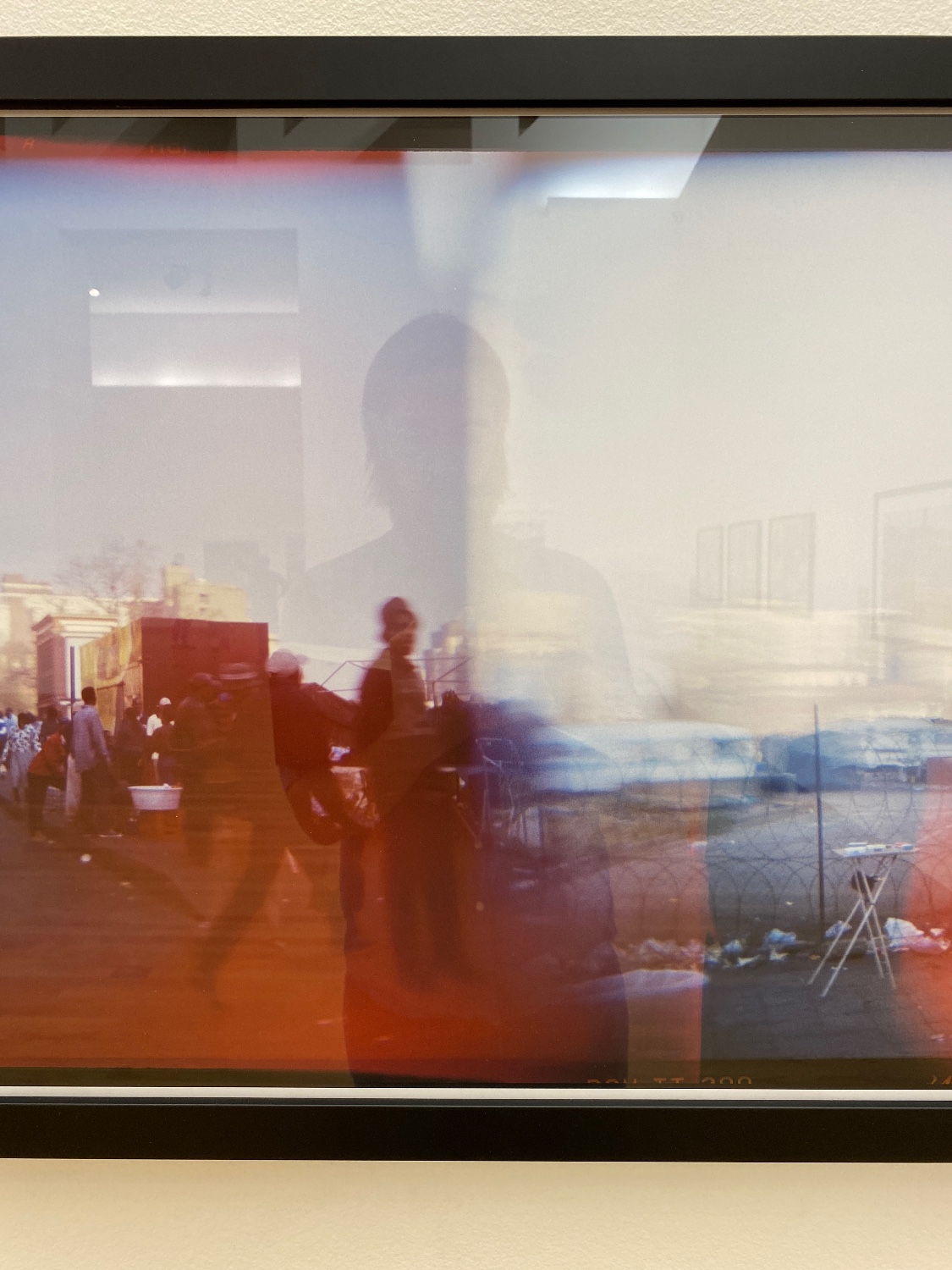 The author in front of Jo Ratcliffe, King George St., Twist St., JOURBERT PARK (Johannesbug: Inner City Works series), 2000-2004.
The author in front of Jo Ratcliffe, King George St., Twist St., JOURBERT PARK (Johannesbug: Inner City Works series), 2000-2004.
Urban Cadence: Street Scenes from Lagos and Johannesburg is on view at Weisman Art Museum through December 31.There will be an artist talk titled "Urban Cadence and the Lens on Africa" Wednesday, October 25, at 6pm, featuring a conversation between curator Carol Magee and Nigerian photojournalist Akintunde Akinleye.
Banner image: Jodi Bieber (South African, b.1966). Alternative rock band Ree-Burth, Pimville, 2009. Digital print. 44 x 52 3/4 inches. Courtesy of the artist.
This activity is made possible by the voters of Minnesota through a grant from the Metropolitan Regional Arts Council, thanks to a legislative appropriation from the arts and cultural heritage fund. 
We can't do it without you.
Help keep independent arts journalism alive in the Twin Cities.